Production Year 2013
Sakura Sakura
DC231330![]()
さくらさくら [RNB]
![]()
![]()
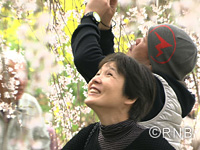
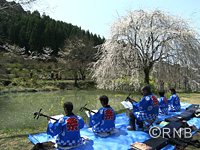
|Length : 48min. |Year : 2013 |
Aino is a village in the island of Shikoku, Japan. The only house remaining in this mountain village is of the Takezaki family, consisting of Grandpa Isamu (78), Grandma Ichiko (76) and their dog.
Spring time is here and the day the Takezakis have been waiting for all year has finally arrived. Today is the day when many visitors will come to view "Aino no Hana" (Flower of Aino), the weeping cherry tree that Grandpa Isamu planted in his youth.
The local people claim that no tree matches the beauty of this cherry tree.
The reason for this is because of its spherical dome-like shape and its beautiful reflection cast on the surrounding pond. But it's also because of the warm smile and hostility that Grandpa Isamu provides to all the visitors...
Visitors will take photos, compose a haiku, and even perform a concert of shamisen (a traditional Japanese string instrument) to embrace the beauty of the tree.
Just for one day of the year, Grandpa Isamu and Grandma Ichiko's house turns into an amusement park! It gets so crowded with visitors that a 75 year-old neighbor helps out to direct the traffic of cars outside. At night, Grandpa Isamu even lights up the tree so that the visitors can enjoy this special day until the very end.
Today is the day the cherry tree is in full bloom.
What will the special day be like this year?
This is the story of a beautiful weeping cherry tree and a couple that lives in an isolated corner of Japan.
Raising Children with Local Food: “Dietary Education” at a Nursery in Hokkaido
DC261308![]()
北海道まるごといただきま~す わんぱく保育園の食育日記 [HBC]
![]()
![]()
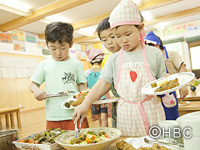
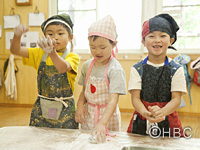
|Length : 46min. |Year : 2013 |
Two adults enroll for a day at a nursery school in Otaru City, Hokkaido.
Education critic Naoki Ogi, also known as Ogi Mama, has become a familiar face on Japanese television, loved for his gentle tone of speech. The main character of the popular TV school-drama series "Kinpachi Sensei" is based on Ogi Mama, as he was once a passionate teacher who always confronted his students.
Partnering Ogi Mama is Naoki Tanaka of the popular comedy group Kokoriko. As a father who is very involved in raising his two sons, Tanaka always walks his kids to kindergarten when he can.
The two Naokis visit NPO Kamome (Seagull) Nursery School in Otaru City.
The biggest feature of the nursery school is its unique dietary education, which aims to nurture the pupils both physically and emotionally. What do the pupils there have for lunch, or for snacks? And how are kids raised on this dietary education different from those who are not?
At this nursery school, sardines that have been cut up and fried in the school kitchen are served, and they come with the bones too! Nowadays in Japan, many food products are advertised as being delicious on the grounds that they are "very soft", but at this nursery school, "softness" is anything but the priority! The motto here is to chew hard foods thoroughly, for chewing well is not only important for the development of the jaw and the body in general, but is also of the utmost importance for a child to develop a sound mind. There are experts who say that kids who chew well do not "lose control".
Right after arriving, the two Naokis tag along the kids to go pick Yomogi buds, for on this day, the snack is Yomogi rice cake, which features the rich aroma of spring!
Meanwhile, at the nursery school kitchen, fried fish using herrings—which are in season—is being prepared. Chopped up Fuki leaves are mixed in the breading that is used for the fried fish. Also on the menu is a stew of Shiitake mushrooms—which the kids grew themselves—with some pickled radish.
Seagull Nursery School emphasizes the importance of being local and eating local food. In summer, the kids heap up mulberry jam on home-made bread; during fall, the season of harvest, the class of five-year-olds makes Soba noodles, tofu, curry with rice, and even pickled herring, all from scratch! By cooking for the younger kids, the class learns the true value of words like "it is delicious!" and "thank you!"
During summer, the kids leave their usual school grounds to spend two summer months at their school building by the beach (called "Seagull by the Sea"). There, the kids spend all day swimming in the sea and running on the sandy beach. Come winter, the nursery school borrows a hut on a mountain from a university mountaineering club. There, the kids sled and play in the snow all day long.
The kids sew their own dust cloth; they braid their own jump rope.
The education offered here is one that develops the kids' strength to live vigorously.
"I ate something I had thought I didn't like, but when I did, it tasted so good!"
"I chewed some hard food really well, and then its taste spread in my mouth!"
"I did it!" "There's nothing you can't do if you work hard for it!"
The pupils infinitely broaden their possibilities through the dietary education offered here.
What is dietary education?
You might discover that the answer to that question has more to it than you think! Watch this program and find out!
 A Passionate Challenger | The Queen of Lighting
A Passionate Challenger | The Queen of Lighting
DC281351![]()
情熱大陸 | 照明デザイナー 石井幹子 [MBS]
![]()
![]()
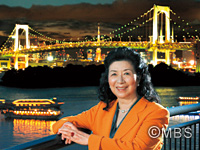
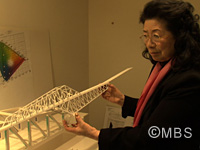
|Length : 24min. |Year : 2013 |
Motoko Ishii has been leading the lighting design industry nearly over half a century. Her innovative designs have earned her the well-deserved reputation as "Japan's Queen of Lighting." In addition to the illumination of the landmark Tokyo Tower and the Osaka Expo '70, Ishii has worked her magic with lights on world stage in architecture and the arts, in projects like Shanghai's World Financial Center, a hotel in Singapore, and light performance events in Germany and Paris. What drives her to always be at the forefront is the desire to "do something new." In that pursuit, she is always on the go, traveling to international illumination trade fairs in Europe, or collaborating with her daughter, Akari-Lisa, who is a lighting designer in her own right.
This program goes behind-the-scenes and follows her work on illuminating the Tokyo Gate Bridge which opened in February 2012. The project had two very strict regulatory limitations on light positioning and brightness. It was an arduous effort that took eight years from planning to fruition and we see Ishii, the consummate lighting designer, passionately and completely in her element.
Vow of an Atomic Bomb Survivor
DC281352![]()
誓い その時 私は14才 [NBC]
![]()
![]()
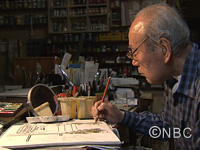
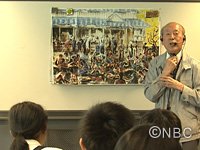
|Length : 24min. |Year : 2013 |
We asked young people in Nagasaki this question: Do you ever think about the atomic bomb?
"It's something from the past", they answered. It reminded us that over sixty years have passed since the atomic bomb dropped on Nagasaki. The event is a distant memory of the past. Even for young people who live in the city where it dropped, the memories are starting to fade.
Hiroshi Matsuzoe is an artist from Nagasaki City. When he was fourteen, he was exposed to the atomic bomb. After retiring from the fire department, he started to depict his memories of the atomic bomb through his paintings, which he made into a kamishibai (pictures on boards that are used for storytelling). Using the kamishibai, he spoke to school children about his experiences, the horrors of nuclear weapons and the value of peace.
When Matsuzoe turned eighty, he was diagnosed with throat cancer. He survived, but his vocal cords were removed and he lost his voice in the surgery. Now he relies on a hole made in his throat to breathe.
Matsuzoe relied on his voice to perform his lifework, recounting atomic bomb experiences. The loss of his voice was extremely unfortunate. After his surgery, he avoided meeting people and stayed home.
Matsuzoe started to paint another kamishibai while he stayed at home. He depicted the experiences of his classmates' who died from the atomic bomb. He wanted to ensure their lives would be honored and not forgotten. Matsuzoe wanted to read his new kamishibai to young people again. He battled his feelings of anxiousness to speak in front of people and started to train and rehabilitate his voice using an artificial larynx. As he worked on his project, another trace of cancer was detected in his lungs.
The average age of atomic bomb survivors is seventy-eight. Many have complicated health issues but are using the little time they have left to tell their atomic bomb experiences so that they won't be forgotten. We look at how these survivors live today by following Matsuzoe's experience.
 The Mark of Beauty | Hasami Ware
The Mark of Beauty | Hasami Ware
DC331317![]()
美の壺 | 波佐見焼 [NHK]
![]()
![]()
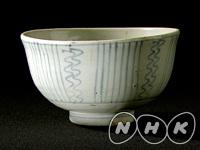

|Length : 29min. |Year : 2013 |
The Hasami ware, baked over a period of 400 years, in Hasami Town, Nagasaki, has a deep, hidden history. We examine a piece acclaimed by connoisseurs as the ultimate example of wabi-sabi, or "simple elegance"; an exotic bottle loved by the great writer Leo Tolstoy; and many more. Join us as we delve into the deep world of beauty that lies in the Hasami, which has travelled back and forth between practicality and beauty over its long history.














